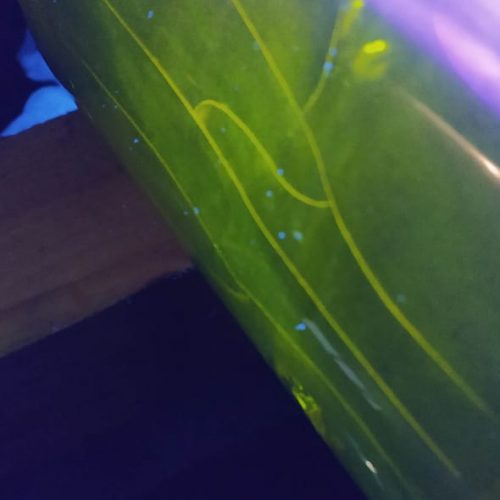Magnetic Particle Testing
This method is used for the detection of surface and near-surface flaws in ferromagnetic materials and is primarily used for crack detection. The specimen is magnetized either locally or overall, and if the material is sound the magnetic flux is predominantly inside the material. If, however, there is a surface-breaking flaw, the magnetic field is distorted, causing local magnetic flux leakage around the flaw. This leakage flux is displayed by covering the surface with very fine iron particles applied either dry or suspended in a liquid. The particles accumulate at the regions of flux leakage, producing a build-up which can be seen visually even when the crack opening is very narrow. Thus, a crack is indicated as a line of iron powder particles on the surface.
The method is applicable to all metals which can be strongly magnetized – ferritic steels and irons, but not generally austenitic steels.
The method of magnetization must produce a magnetic field with lines of force at a large angle to the expected direction of the cracks to be detected, so that it is usual to apply the magnetization more than once in different directions, for example in two directions mutually at right-angles, but methods of swinging the field direction during magnetization are available.
- The magnetization may be produced by any of the following methods:
- Applying a permanent or electro-magnet to the surface (magnetic flow)
- Passing a large current through the specimen, or locally by means of current prods (current flow)
- Putting the specimen inside a current-carrying coil, or forming a coil around the specimen
- Making the specimen the secondary loop of a transformer – (induced current) – suitable for ring-shaped specimens
- Placing a current-carrying coil or loop close to the specimen surface
- Threading a current-carrying bar through a hollow specimen.
The electric current used may be DC or AC of any waveform, but the current required to produce adequate magnetization depends on the waveform of the supply, the magnetization method used, and the material of the specimen. It is most important to ensure that the current used is correct for the specimen size and shape and also that the direction of the magnetic flux produced is suitable for the crack expected.
By using a combination of two magnetic fields, a swinging or rotating magnetic flux can be produced, which will detect a crack in any orientation.
Usually the iron particles – dry powder or suspended in a liquid (magnetic ink) – are applied while the magnetizing current is still flowing, but residual magnetization is sometimes used, when the particles are applied after magnetization. Some steels retain sufficient magnetization for this method to be satisfactory, and in this case smaller, more portable, magnetizing equipment can be used. Magnetic inks (particles suspended in a liquid) are used more widely than dry powders. They are applied by low-pressure spray, dipping or brushing; it is important to use plenty of ink and to allow time for the particles to flow over the surface and migrate to any cracks. On dark surfaces a very thin layer of white paint can be applied to give a higher contrast indication.
Fluorescent particles, which require UV-A illumination, are widely used and colored particles are also available. The indications of cracks can be preserved by photography or by the use of peel-off transparent adhesive film. MPI methods can be applied to relatively rough and dirty surfaces, but the flaw sensitivity may be impaired. Magnetic methods for underwater applications have been developed. Only under very special conditions can sub-surface flaws be detected by MPI.

